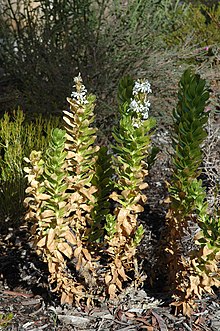청옥수수
Blue corn
푸른 옥수수(호피 옥수수, 요메 블루, 타라후마라 마이즈 아줄, 리오 그란데 블루로도 알려져 있음)는 멕시코, 미국 남서부, [1][2][3]미국 남동부에서 재배되는 부싯돌 옥수수이다.그것은 틀라코요로 알려진 멕시코 남부와 중부 전통 음식에 사용되는 주요 옥수수 종류 중 하나이다.
그것은 원래 호피족, 뉴멕시코 리오 그란데의 푸에블로 인디언, 그리고 [2]체로키족을 포함한 몇몇 남동부 부족에 의해 개발되었다.피키빵 등 호피요리의 필수품이다.블루콘밀은 통째로 블루콘을 갈아 단맛을 내는 옥수수 가루입니다.그것은 또한 토르티야를 [4]만드는 데 흔히 사용되는 뉴멕시코 요리의 주요 재료이기도 하다.
품종
1950년대에 확인된 다섯 개의 호피 블루 콘 품종은 식물의 높이, 알맹이 무게, 알맹이 폭, [2]알맹이 두께와 같은 몇 가지 특징에 대해 상당한 차이를 보였다.다른 변종들은 거의 검은색에서 파란색-회색을 띠며, 이름은 "표준" 파란색, 딱딱한 파란색, 그리고 회색-청색에서 유래했다.[5]
전통적인 호피 블루 콘 품종은 가뭄에 강하고 뿌리가 깊으며 키가 4~5피트를 넘지 않는 다소 짧은 식물이다.리오그란데 푸에블로 블루콘 품종은 키가 더 크고, 수확량이 더 높으며, 호피 품종만큼 가뭄에 잘 견디지 못합니다.두 종류의 푸른 옥수수는 깊고 모래가 많은 [6]흙을 선호한다.
푸른 옥수수의 다른 토종 품종으로는 애리조나 솔트 리버 피마 보호구역에서 재배되는 짧고(3~4피트), 덤불하며 매우 내열성이 뛰어난 낮은 사막 푸른 옥수수 품종인 요메 블루와 북부 시에라 국경 사막에서 재배되는 타라후마라 북부 멕시코 품종인 타라후마라 마이즈 아줄 등이 있다.Tarahumara Maiz Azul은 Tarahumaran 옥수수 [6][7][8][9][10]맥주인 tesguino뿐만 아니라 멕시코에서 토르티야와 타말레를 만드는데 널리 사용된다.
체로키 인디언의 동부 밴드에서 유래한 체로키 가보의 푸른 옥수수는 체로키 화이트 이글 콘이라고 불리며 체로키 국가 종자 은행의 체로키 부족원들에게 분배된다.키가 크고 5~7피트에 달하며 [11]수확량이 많다.
토르티야 단백질 함량
청옥수수 토르티야 100g의 단백질 함량은 7.8%[12]인데 비해 황옥수수 토르티야는 [13]5.7%다.
안토시아닌류
미국 남서부에서 재배되는 푸른 옥수수의 종류는 각각의 안토시아닌 함량이 다양하며, 이 안토시아닌은 옥수수 고유의 [14]색깔을 내는 폴리페놀 색소이다.가장 함량이 높은 안토시아닌은 시아니딘 3-글루코시드([14]가장 풍부한), 펠라르고니딘 및 페오니딘 3-글루코시드이다.
식품 사용
또띠야와 시리얼의 전통적인 남서부 요리에 사용되는 것 외에도 블루콘은 블루콘칩이나 블루콘 팬케이크 [2][15]믹스 같은 제품에 상업적으로 사용된다.
심볼릭 용도
호피족은 종교적 의식에 옥수수를 사용했는데, 노란색 옥수수는 북서쪽, 파란색 옥수수는 남서쪽, 빨간색 옥수수는 남동쪽, 흰색 옥수수는 북동쪽, 검은색 옥수수는 위쪽에, 그리고 모든 [16][17]색깔의 옥수수는 아래쪽에 있는 방향적 연관성의 틀에 놓았습니다.
「 」를 참조해 주세요.
레퍼런스
- ^ Soleri, D; Cleaveland, D. (1993). "Hopi Crop Diversity and Change" (PDF). Journal of Ethnobiology. Society of Ethnobiology. 13 (2): 203–231. Archived (PDF) from the original on 2011-07-16. Retrieved 2010-08-07.
- ^ a b c d Johnson, Duane L.; Jha, Mitra N. (1993), "Blue Corn", in Janick, Jules; Simon, James E. (eds.), New Crops, New York: John Wiley & Sons, pp. 228–230, ISBN 0-471-59374-5, retrieved 2010-07-23
- ^ "About Us". Cherokee Nation. Retrieved 2019-02-21.
- ^ McKee, Gwen; Barbara Moseley (1999). Best of the Best from New Mexico Cookbook: Selected Recipes from New Mexico's Favorite Cookbooks. Quail Ridge Press. ISBN 978-0-937552-93-3.
- ^ Soleri, D; Cleaveland, D. (1993). "Seeds of strength for Hopis and Zunis". Seedling. 10 (4): 13–18. Archived from the original on 2010-06-20. Retrieved 2010-08-07.
- ^ a b "Rio Grande Blue Corn New Mexico Farming Conference" (PDF). Archived from the original (PDF) on 2018-09-19. Retrieved 2018-09-18.
- ^ "Tarahumara Maiz Azul - Native-Seeds-Search". shop.nativeseeds.org.
- ^ "Yoeme Blue - Native-Seeds-Search". shop.nativeseeds.org. Archived from the original on August 25, 2015.
- ^ "Zea mays ( Yoeme Blue Corn ) - Backyard Gardener". 21 September 2016.
- ^ "Zea mays ( Tarahumara Maiz Azul Corn ) - Backyard Gardener". 21 September 2016.
- ^ "Seed Bank Plant Listing". Cherokee Nation. Retrieved 2019-02-21.
- ^ "Basic nutrition report per 100 grams: 35239, Tortilla, blue corn, Sakwavikaviki (Hopi)". US Department of Agriculture, National Nutrient Database; Standard Reference 28. 2016. Archived from the original on 31 May 2017. Retrieved 11 June 2017.
- ^ "Basic nutrition report per 100 grams: 18449, Tortillas, ready-to-bake or -fry, corn, without added salt". US Department of Agriculture, National Nutrient Database; Standard Reference 28. 2016. Archived from the original on 15 November 2017. Retrieved 11 June 2017.
- ^ a b Nankar, A. N.; Dungan, B; Paz, N; Sudasinghe, N; Schaub, T; Holguin, F. O.; Pratt, R. C. (2016). "Quantitative and qualitative evaluation of kernel anthocyanins from southwestern United States blue corn". Journal of the Science of Food and Agriculture. 96 (13): 4542–52. doi:10.1002/jsfa.7671. PMID 26879128.
- ^ Aronson, Earl (December 1, 1990). "Blue Corn: A Food Fad Lasting for Centuries". Los Angeles Times. Archived from the original on November 6, 2012. Retrieved April 19, 2012.
- ^ Stephen, Alexander M. (1936), Parsons, Elsie Clews (ed.), Hopi Journal of Alexander M. Stephen, New York: Columbia University Press, pp. 961, 1191
- ^ Hieb, Louis A. (1979), "Hopi World View", in Ortiz, Alfonso (ed.), Handbook of North American Indians, vol. 9, Southwest, Washington, DC: Smithsonian Institution, pp. 577–580,
The Hopi cultural construction of space is a quadripartite one to which are added 'up' and 'down'.… From this middle place paths of cornmeal radiate outward to the six directions and various objects (including ears of corn,…) are added according to their position in the system of correspondences.





